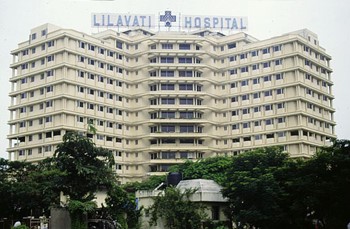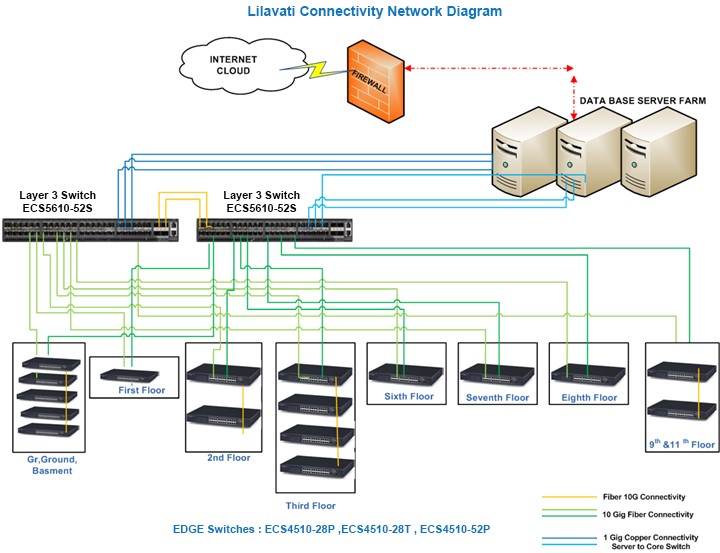Lilavati Hospital Mumbai Network Case Study

The hospital is located in the heart of Mumbai (India) and is very close to the domestic and the international airports. The hospital started functioning in 1997 with 10 beds and initially had only 22 doctors. Today, it boasts of 314 beds with one of the largest Intensive Care Units (ICUs) in India, most advanced 12 operation theaters, more than 300 consultants, and manpower of nearly 1,800. The hospital attends to around 300 in-patients and 1,500 out-patients daily.
Business Challenge
The environment surrounding medical care and technology has evolved rapidly over the past years. In order to keep at the forefront of this changing environment, Lilavati Hospital had to put in place a comprehensive network upgrade plan. The hospital's original network ran at 100 Mbps, and included unmanaged switches and hubs, meeting the initial requirements for simple data transfer. It was primarily used for accounting and the exchange of medical test information. Traffic was initially low but vastly increased as the number of PCs, and thus the demand for Q management, HIS software, patient digital reports, video conferencing, email, and Internet capabilities grew. The hospital's association with other establishments, such as a junior nurses' school and a clinical laboratory center, further stretched the LAN's capabilities, causing performance issues. With 700 plus staff, 314 beds for patients, and 1500 + outdoor patients, the number of people needing to exchange information had increased beyond what the hospital's network was capable of supporting, in terms of bandwidth, and the system had become unreliable (one fault could take out the whole network). The LAN was severely limiting the hospital's efficiency and thus impeding its ability to remain at the forefront.
In addition to an increase in traffic, Lilavati expanded its facilities and the number of services it provided also markedly increased. New technological capabilities, such as Magnetic Resonance Imaging (MRI), became available, and existing services, such as diagnosis collaboration, were promoted. These expansions meant that the network capabilities required by the hospital went well beyond increased bandwidth -- the hospital now required a highly reliable, resilient, and scalable network infrastructure.
Objective
To achieve their objectives, Lilavati Hospital turned to Edge-Core on the basis of their proven history of delivering highly reliable and feature-rich advanced network solutions. Edge-Core were also able to meet the requirements for a resilient and scalable solution within the hospital's budget.
Approach
Move toward higher bandwidth with lower-cost, a longer-term model based on servers, networking products and homogenous network components to deliver centralized management of computing across the network.
Business technology improvements
- Increased network bandwidth between campus floor-to-floor switches from 100 Mbps to a 10 Gbps backbone. Better supports the increased use of the network for content and course delivery.
- Service calls and outages have been reduced from weekly to near zero, freeing staff to focus on higher-value projects and satisfactory services to the patients.
- Network Higher Bandwidth, deployment, management, monitoring, and troubleshooting are now easier with use of Edge-Core Manged networking solution.
Network Solution

Two Layer-3 (ECS5610-52S) 10G switches are installed at the core of the network in full redundant mode with VRRP configuration. A firewall ensures that up to 1 Gbps of traffic can flow at wire speed through to the Internet. A 10 Gbps backbone was deployed to ensure higher bandwidth that worked in a non-blocking mode across the Hospital. Security enhancements from internal and external threats: Traffic classification and segregation with security by VLANs, ACLs, broadcast storm control, and anti D-DoS attacks on managed Edge-core switches.
Segmentation of the network has been achieved through the use of Virtual LANs (VLANs). The main advantage of using VLANs is that users can be grouped together according to their networking needs, regardless of their actual physical locations. Subdividing the LAN into smaller segments, or VLANs, increases overall reliability, security, and performance, and makes the network easier to maintain. The hospital now easily maintains separate VLANs for different areas, such as medical examination, office work, and patients.
PoE-enabled switches (ECS4510-28P and ECS4510-52P) give extra reliability and scalability to extend PoE-enabled devices at any time, such as access-points (wireless connectivity), surveillance products, cameras, and access gateways, etc. All the Edge-Core PoE switches provide full 802.3at support on all ports.
Deploying an end-to-end solution also helped Lilavati Hospital overcome the challenge of finding and retaining skilled manpower to manage complex technologies, because the solution helped increase dependency and trust in the network.
During the implementation, wireless planning needed to be re-adjusted to the requirements of video throughput, manageability, and the security expected by students. The senior management and the technical team at Lilavati Hospital worked hand-in-hand with the team from Edge-Core to complete the project successfully.
Advanced network monitoring allows accurate and up-to-date statistics to be gathered about network resources, ensuring a pro-active approach to network infrastructure maintenance and support.
Business Results
The LAN implementation allows the convergence of voice, video, and data. Hospital staff can now utilize the network for information sharing both efficiently and effectively, for example, graphical content can be referred directly from examination rooms, and the Clinical Laboratory Center examination results can be easily checked on a real-time basis. An ordering system was introduced as an electronic chart system. These capabilities, and more, mean the hospital now has a highly advanced infrastructure.
The ability for staff to communicate in real-time has proven a huge time saver, and has reduced the need for manual, paper-based systems, resulting in an increase of staff efficiency and productivity, and therefore an improved quality of patient care.
Staff now have greater access to educational resources, both from the Internet and from the Clinical Laboratory Center, which provides advanced online services across the Intranet. Furthermore, these resources consist of the latest information in digital form.
Objective Achieved
The new Edge-Core switch network allows Lilavati Hospital to stay at the forefront and keep abreast of technological advances. The hospital's collaborative partnership with other institutions is now easily maintained, thanks to high quality bilateral communication capabilities, and patient information is effectively stored and retrieved when necessary.
Product Used in this Case Studies
ECS5610-52S L3 10Gigabit Data Center Switch
ECS4510-28T L2+ GE Aggregation Switch
ECS4510-28P L2+ GE Aggregation Switch with PoE
ECS4510-52P L2+ GE Aggregation Switch with PoE




